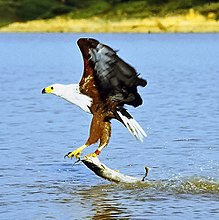Fish eagle
| Fish eagle | ||||||||||
|---|---|---|---|---|---|---|---|---|---|---|

Fish eagle ( Haliaeetus vocifer ) |
||||||||||
| Systematics | ||||||||||
|
||||||||||
| Scientific name | ||||||||||
| Haliaeetus vocifer | ||||||||||
| ( Daudin , 1800) |
The fish eagle ( Haliaeetus vocifer ) is an African bird of prey from the hawk family (Accipitridae).
features
With a body length of 63 to 75 cm and a wingspan of 175 to 210 cm, fish eagles are medium-sized sea eagles . The females are slightly larger than the males. Males weigh 2.0-2.5 kg, females 3.2-3.6 kg. Their appearance is unmistakable, the head, neck, upper parts of the chest and back and the tail are snow-white, the rest of the body is red-brown to maroon to gray. The wings are black. The beak is yellow with a black tip. Wax skin and legs are light yellow. Fish eagles have two distinct, distinctive calls. A “quock” can be heard near the nest. Otherwise, the calls to the territory in Africa are unmistakable and are also called "the voice of Africa". Usually a couple calls in a duet, with females the calls sound a bit shrillier. It is typical for African fish eagles that they tuck their heads back when they call while sitting or in flight.
behavior
Fish eagles usually sit in the crowns of tall trees, from where they can observe their territory, the course of the river, the lake shore or the coastline very well.
Occurrence
Fish eagles are common in sub- Saharan Africa up to 1,000 m above sea level. They occur on rivers, lakes and coasts.

nutrition
Fish eagles mainly eat fish, but more rarely they also hunt lesser flamingos , ibises , storks and other water birds . Small turtles , small crocodiles , frogs , sea snakes and carrion are also occasionally used. Fish eagles are extremely skilled fliers and often steal prey from other birds . They wait in a waiting room in a tall tree until they discover a prey fish on the surface of the water. Then they rush down, grab the prey and fly back to the control room to eat it. From a weight of approx. 1.5 kg they can no longer carry the prey, then they swim to the bank and eat the prey fish there.
Reproduction
They make their nests on tall trees, in bushes or on cliffs near the water. The female lays one to three white eggs with a few reddish spots every two to four days, most of which are hatched by the female in about six weeks. After nine to ten weeks the chicks are fledged and after another eight weeks they are able to beat their own food. Fish eagles are sexually mature at the age of four.
Hazard and protection
The world population is estimated at 100,000 to 200,000 pairs, so they are currently not endangered according to the IUCN .
Others
The fish eagle is one of the heraldic animals of Namibia and the heraldic animal of South Sudan .
literature
- J. Ferguson-Lees, DA Christie: Raptors of the World. Christopher Helm, London 2001, ISBN 0-7136-8026-1 .
- Leslie H. Brown : The African fish eagle. Baileys, Swinfen & Purnell, Folkestone / London / Cape Town 1980, ISBN 0-561-00304-1 .
- Helen Roney Sattler, Jean Zallinger: The book of eagles. Lothrop, Lee & Shepard, New York 1989, ISBN 0-688-07022-1 .
Web links
- www.arcanus.ch - Article and photo of the Schreiseeadler ( Memento from February 21, 2011 in the Internet Archive )
- Haliaeetus vocifer in the endangered Red List species the IUCN 2008. Posted by: BirdLife International, 2008. Accessed January 31 of 2009.
- Videos, photos and sound recordings for Haliaeetus vocifer in the Internet Bird Collection
